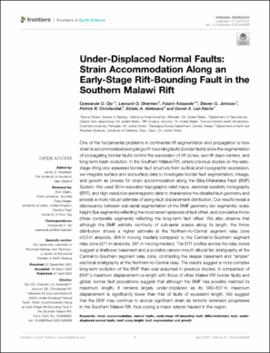| dc.contributor.author | Ojo, Oyewande O. | |
| dc.contributor.author | Ohenhen, Leonard O. | |
| dc.contributor.author | Kolawole, Folarin | |
| dc.contributor.author | Johnson, Steven G. | |
| dc.contributor.author | Chindandali, Patrick R. | |
| dc.contributor.author | Atekwana, Estella A. | |
| dc.contributor.author | Lao-Davila, Daniel A. | |
| dc.date.accessioned | 2022-04-19T20:18:08Z | |
| dc.date.available | 2022-04-19T20:18:08Z | |
| dc.date.issued | 2022-04-07 | |
| dc.identifier | oksd_laodavila_underdisplacednormalfaults_2022 | |
| dc.identifier.citation | Ojo, O. O., Ohenhen, L. O., Kolawole, F., Johnson, S. G., Chindandali, P. R., Atekwana, E. A., & Lao-Davila, D. A. (2022). Under-displaced normal faults: Strain accommodation along an early-stage rift-bounding fault in the Southern Malawi Rift. Frontiers in Earth Science, 10, Article 846389. https://doi.org/10.3389/feart.2022.846389 | |
| dc.identifier.uri | https://hdl.handle.net/11244/335256 | |
| dc.description.abstract | One of the fundamental problems in continental rift segmentation and propagation is how strain is accommodated along large rift-bounding faults (border faults) since the segmentation of propagating border faults control the expression of rift zones, syn-rift depo-centers, and long-term basin evolution. In the Southern Malawi Rift, where previous studies on the early-stage rifting only assessed border fault structure from surficial and topographic expression, we integrate surface and subsurface data to investigate border fault segmentation, linkage, and growth as proxies for strain accommodation along the Bilila-Mtakataka Fault (BMF) System. We used 30�m-resolution topographic relief maps, electrical resistivity tomography (ERT), and high-resolution aeromagnetic data to characterize the detailed fault geometry and provide a more robust estimate of along-fault displacement distribution. Our results reveal a discrepancy between sub-aerial segmentation of the BMF geometry (six segments), scarp height (five segments) reflecting the most recent episodes of fault offset, and cumulative throw (three composite segments) reflecting the long-term fault offset. We also observe that although the BMF exhibits continuity of sub-aerial scarps along its length, the throw distribution shows a higher estimate at the Northern-to-Central segment relay zone (423�m absolute, 364�m moving median) compared to the Central-to-Southern segment relay zone (371�m absolute, 297�m moving median). The ERT profiles across the relay zones suggest a shallower basement and a possible canyon-mouth alluvial fan stratigraphy at the Central-to-Southern segment relay zone, contrasting the deeper basement and 'simpler'� electrical stratigraphy at the Northern-to-Central relay. The results suggest a more complex long-term evolution of the BMF than was assumed in previous studies. A comparison of BMF's maximum displacement-vs-length with those of other Malawi Rift border faults and global normal fault populations suggest that although the BMF has possibly reached its maximum length, it remains largely under-displaced as its 580-837�m maximum displacement is significantly lower than that of faults of equivalent length. We suggest that the BMF may continue to accrue significant strain as tectonic extension progresses in the Southern Malawi Rift, thus posing a major seismic hazard in the region. | |
| dc.format | application/pdf | |
| dc.language | en_US | |
| dc.publisher | Frontiers Media SA | |
| dc.relation.ispartof | Frontiers in Earth Science, 10 | |
| dc.rights | This material has been previously published. In the Oklahoma State University Library's institutional repository this version is made available through the open access principles and the terms of agreement/consent between the author(s) and the publisher. The permission policy on the use, reproduction or distribution of the material falls under fair use for educational, scholarship, and research purposes. Contact Digital Resources and Discovery Services at lib-dls@okstate.edu or 405-744-9161 for further information. | |
| dc.title | Under-displaced normal faults: Strain accommodation along an early-stage rift-bounding fault in the Southern Malawi Rift | |
| dc.date.updated | 2022-04-15T18:43:51Z | |
| osu.filename | oksd_laodavila_underdisplacednormalfaults_2022.pdf | |
| dc.description.peerreview | Peer reviewed | |
| dc.identifier.doi | 10.3389/feart.2022.846389 | |
| dc.description.department | Geology | |
| dc.type.genre | Article | |
| dc.type.material | Text | |
| dc.subject.keywords | 0403 Geology | |
| dc.subject.keywords | 0404 Geophysics | |
| dc.subject.keywords | 0406 Physical Geography and Environmental Geoscience | |
| dc.relation.oaurl | https://www.frontiersin.org/articles/10.3389/feart.2022.846389/full | |
| dc.identifier.author | ORCID: 0000-0003-0584-458X (Lao-Davila, Daniel A) | |
| dc.identifier.author | ScopusID: 35105202100 (Lao-Davila, Daniel A) | |
